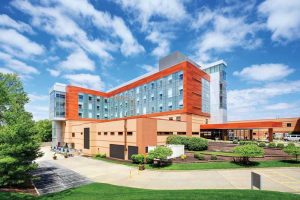
In 2018, the ICC formed the Building Safety & Security Committee to comprehensively explore and assess building safety and security.4 The committee is comprised of experts who touch the building industry such as building owners, facility managers, the education sector and security fields, code officials, engineers, architects, standards developing organizations such as the National Fire Protection Association (NFPA), and the federal government. They help ensure code compliance and advise on other construction considerations that may affect building safety and comfort.
IWR North America, based in St. Louis, Missouri, has recently undertaken projects involving the fortification of doors and means of egress in school districts using ballistics resistant glass. Designing functional yet safe doors requires addressing two primary components: building hardening and
access control.
Building hardening encompasses various measures to reinforce the physical glazing of doors, walls, windows, and related components to enhance security. When it comes to doors, there is range of solutions available depending on the desired level of security and budget. For instance, one approach could involve adding a layer of laminated glass to the inside of an existing glass door, which provides an increased level of security while preserving the door’s original appearance. Alternatively, doors and frames can be replaced with a ballistic-rated system specifically designed to withstand forced entry attempts. This more robust solution offers higher levels of security, but may come with a different budget requirement.
Access control refers to the electronic technology that integrates with the doors’ locking mechanisms. This technology allows for secure entry and exit, often incorporating features such as key card systems, biometric authentication, or remote monitoring. By implementing effective access control measures, organizations can regulate and monitor access to their facilities, further bolstering overall security.
Designing for increased security through building hardening and access control requires a comprehensive evaluation that considers factors such as the specific threats faced, available budget, and other site-specific considerations. It is essential to prioritize security measures based on the level of threat and the cruciality of the areas being protected. Organizations looking to develop a comprehensive plan for enhancing security in their buildings can rely on resources such as the Partner Alliance for Safer Schools (PASS), which provides guidance and best practices for creating secure educational environments.
By carefully evaluating and implementing appropriate measures for building hardening and access control, organizations can achieve functional yet safe doors that contribute to a secure and protected environment for occupants.
Research and development are constantly being conducted to develop new products, systems, and widgets to keep up with the demand for innovations that improve comfort and security. Part of that research is informed by standards developed by ASTM International to determine the ability of windows and doors to restrain, delay, or frustrate a forced entry event.




